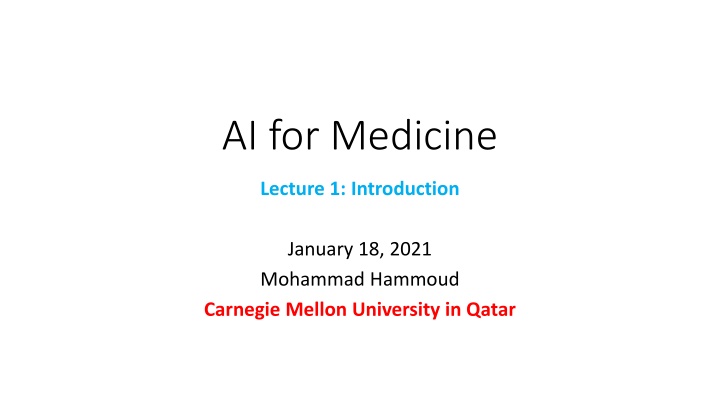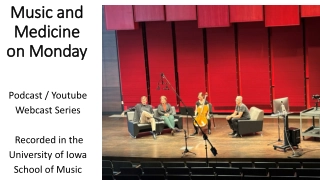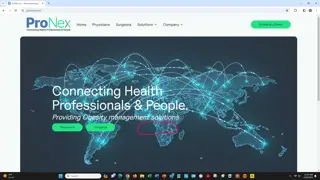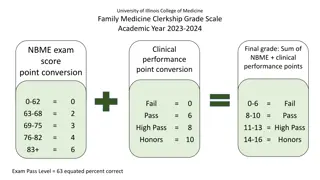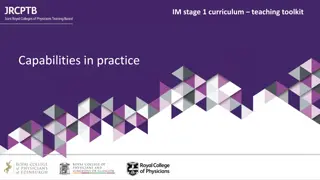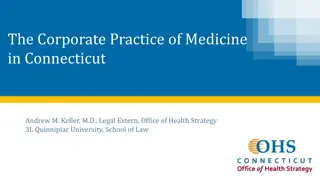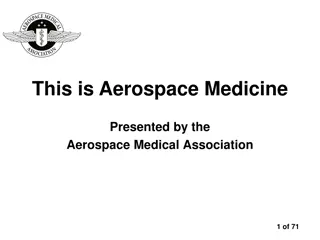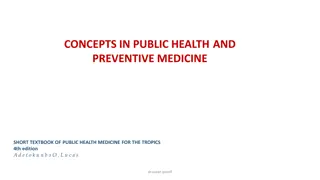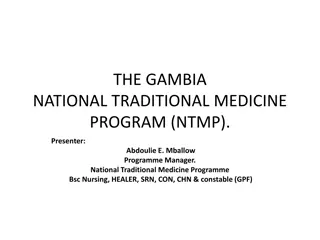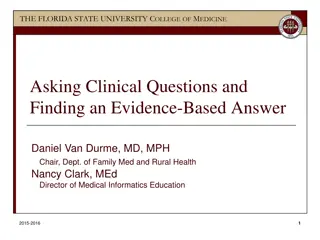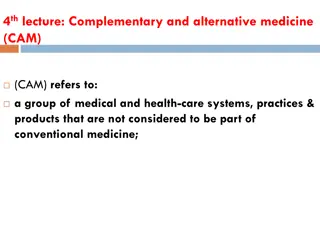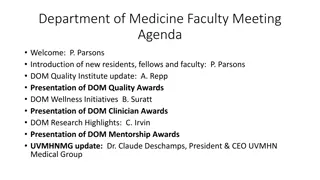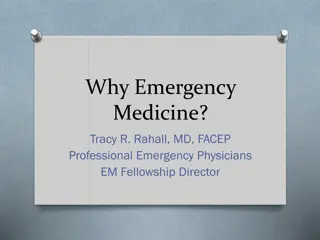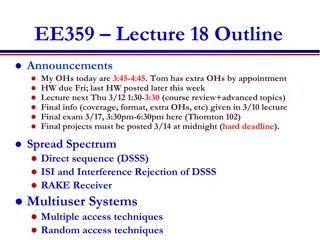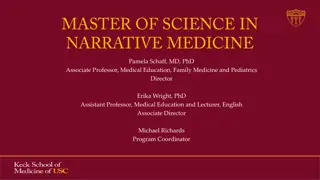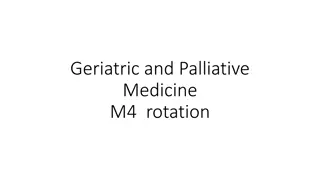An Overview of AI Applications in Medicine - Lecture Highlights
Introduction to AI for Medicine Lecture 1 at Carnegie Mellon University in Qatar, presented by Mohammad Hammoud. The lecture covers the impact of AI on various sectors like work, economy, medicine, and mobility. It delves into the definition of AI, showcasing examples of AI processes in computer vision, speech recognition, machine translation, and neural networks. Explore the potential breakthroughs and advancements AI can bring to the field of medicine.
Download Presentation

Please find below an Image/Link to download the presentation.
The content on the website is provided AS IS for your information and personal use only. It may not be sold, licensed, or shared on other websites without obtaining consent from the author.If you encounter any issues during the download, it is possible that the publisher has removed the file from their server.
You are allowed to download the files provided on this website for personal or commercial use, subject to the condition that they are used lawfully. All files are the property of their respective owners.
The content on the website is provided AS IS for your information and personal use only. It may not be sold, licensed, or shared on other websites without obtaining consent from the author.
E N D
Presentation Transcript
AI for Medicine Lecture 1: Introduction January 18, 2021 Mohammad Hammoud Carnegie Mellon University in Qatar
Outline Introduction AI Applications in Medicine Administrivia What is AI?
On the Verge of Major Breakthroughs Artificial Intelligence (AI) has been moving extremely quickly in the last few years, demonstrating a potential to revolutionize every aspect of our lives Work Economy Medicine Mobility
But, What is AI? AI can be broadly defined as technology that can learn and produce intelligent behavior Input Output Pixels: Tuberculosis An AI Process Computer Vision
But, What is AI? AI can be broadly defined as technology that can learn and produce intelligent behavior Input Output Four kids are playing with a ball An AI Process Pixels: More than just a category about the image! Computer Vision
But, What is AI? AI can be broadly defined as technology that can learn and produce intelligent behavior Input Output Audio Clip: I feel some eye pain An AI Process Speech Recognition
But, What is AI? AI can be broadly defined as technology that can learn and produce intelligent behavior Input Output Text: Hello, how are you? Bonjour, comment allez-vous An AI Process Machine Translation
But, What is AI? Think of this as incoming impulses (input) passed from one neuron (AI process) to the next, if any, and finally generating an output Input Output AI process, which is essentially a mathematical function-- more on this next week
But, What is AI? You can connect as many of these neurons as needed, resulting in what is called a neural network (a branch of AI) The more layers you add, the deeper it becomes. Deep ones are referred to as deep neural networks or deep learning (DL) models
But, What is AI? Subsequently, you can train your DL model Pneumonia Tuberculosis Tuberculosis Example 1
But, What is AI? Again, with a different known example Pneumonia Tuberculosis Tuberculosis Example 2
But, What is AI? Yet again, with yet another different known example Pneumonia Tuberculosis Tuberculosis Repeat until it learns the patterns of Tuberculosis (and Pneumonia) in input images Example 3
But, What is AI? After training your DL model, you can use it to infer what an unknown image may show Pneumonia Tuberculosis Tuberculosis ?
But, What is AI? DL is just a branch of machine learning, which is a branch of AI Deep Learning (DL) Machine Learning (ML) Artificial Intelligence (AI) AI ML DL Computer Science Math Physics Chemistry Biology
Outline Introduction AI Applications in Medicine Administrivia What is AI?
Objectives This course will: 1. Demystify major AI concepts for you (e.g., machine learning, neural networks, Bayesian networks, etc.,) 2. Take you through a journey of AI applications in medicine 3. Allow you to navigate several societal issues and ethical concerns that surround AI
Learning Outcomes After finishing the course, you will be able to: LO # LO # LO # LO # LO # LO # LO # Description Description Description Description Description Description Description 1 1 1 1 1 1 1 Define AI and discuss what AI can and cannot do Define AI and discuss what AI can and cannot do Define AI and discuss what AI can and cannot do Define AI and discuss what AI can and cannot do Define AI and discuss what AI can and cannot do Define AI and discuss what AI can and cannot do Define AI and discuss what AI can and cannot do 2 2 2 2 2 2 2 Recognize various AI applications in medicine and describe how they are transforming healthcare Recognize various AI applications in medicine and describe how they are transforming healthcare Recognize various AI applications in medicine and describe how they are transforming healthcare Recognize various AI applications in medicine and describe how they are transforming healthcare Recognize various AI applications in medicine and describe how they are transforming healthcare Recognize various AI applications in medicine and describe how they are transforming healthcare Recognize various AI applications in medicine and describe how they are transforming healthcare 3 3 3 3 3 3 3 Appreciate the power of big data in enabling AI and describe the different types of data Appreciate the power of big data in enabling AI and describe the different types of data Appreciate the power of big data in enabling AI and describe the different types of data Appreciate the power of big data in enabling AI and describe the different types of data Appreciate the power of big data in enabling AI and describe the different types of data Appreciate the power of big data in enabling AI and describe the different types of data Appreciate the power of big data in enabling AI and describe the different types of data representations representations representations representations representations representations representations 4 4 4 4 4 4 4 Recognize the power of AI algorithms in solving medical problems and discuss how they can be Recognize the power of AI algorithms in solving medical problems and discuss how they can be Recognize the power of AI algorithms in solving medical problems and discuss how they can be Recognize the power of AI algorithms in solving medical problems and discuss how they can be Recognize the power of AI algorithms in solving medical problems and discuss how they can be Recognize the power of AI algorithms in solving medical problems and discuss how they can be Recognize the power of AI algorithms in solving medical problems and discuss how they can be applied in the medical field applied in the medical field applied in the medical field applied in the medical field applied in the medical field applied in the medical field applied in the medical field 5 5 5 5 5 5 5 Describe different AI concepts, including machine learning, deep learning, recommendation systems, ranked retrievals, and probabilistic graphical models, among others ranked retrievals, and probabilistic graphical models, among others ranked retrievals, and probabilistic graphical models, among others ranked retrievals, and probabilistic graphical models, among others ranked retrievals, and probabilistic graphical models, among others ranked retrievals, and probabilistic graphical models, among others ranked retrievals, and probabilistic graphical models, among others Describe different AI concepts, including machine learning, deep learning, recommendation systems, Describe different AI concepts, including machine learning, deep learning, recommendation systems, Describe different AI concepts, including machine learning, deep learning, recommendation systems, Describe different AI concepts, including machine learning, deep learning, recommendation systems, Describe different AI concepts, including machine learning, deep learning, recommendation systems, Describe different AI concepts, including machine learning, deep learning, recommendation systems, 6 6 6 6 6 6 6 Apply some AI techniques to solve real-world medical problems (only for CMU-Q students) Apply some AI techniques to solve real-world medical problems (only for CMU-Q students) Apply some AI techniques to solve real-world medical problems (only for CMU-Q students) Apply some AI techniques to solve real-world medical problems (only for CMU-Q students) Apply some AI techniques to solve real-world medical problems (only for CMU-Q students) Apply some AI techniques to solve real-world medical problems (only for CMU-Q students) Apply some AI techniques to solve real-world medical problems (only for CMU-Q students) 7 7 7 7 7 7 7 Discuss several societal issues and ethical concerns surrounding AI Discuss several societal issues and ethical concerns surrounding AI Discuss several societal issues and ethical concerns surrounding AI Discuss several societal issues and ethical concerns surrounding AI Discuss several societal issues and ethical concerns surrounding AI Discuss several societal issues and ethical concerns surrounding AI Discuss several societal issues and ethical concerns surrounding AI
Structure The course has two versions: 15-182: 6 units, no project, and only 1 lecture per week 15-282: 9 units, 1 big project, and 2 lectures per week Three main teaching tools will be used: Zoom, Piazza, and Gradescope No textbook is required Slides will be self-contained, but you are encouraged to take notes All material will be posted on the course website There will be 6 CAs (contacts and office hours are on the website)
Assessment Methods How will we measure learning? Type # 4 Weight Homework Assignments 40% for 15-182 and 15% for 15-282 20% Quizzes 4 Exams 2 35% Project (only for 15-282) Attendance and Participation 1 25% for 15-282 5% 26 for 15-282 and 12 for 15- 182
Outline Introduction AI Applications in Medicine Administrivia What is AI?
Some Applications of AI in Medicine 1. Diagnosing diabetic eye disease using deep learning [1] 2. Detecting anemia from retinal fundus images using deep learning [2] 3. Predicting cardiovascular risk factors from retinal fundus photographs using deep learning [3] 4. Performing differential diagnosis using probabilistic graphical models [4] 5. Extracting symptoms and their status from clinical conversations using recurrent neural networks [5] 6. Predicting osteoarthritis using machine learning [6]
Some Applications of AI in Medicine 1. Diagnosing diabetic eye disease using deep learning [1] 2. Detecting anemia from retinal fundus images using deep learning [2] 3. Predicting cardiovascular risk factors from retinal fundus photographs using deep learning [3] 4. Performing differential diagnosis using probabilistic graphical models [4] 5. Extracting symptoms and their status from clinical conversations using recurrent neural networks [5] 6. Predicting osteoarthritis using machine learning [6]
Diagnosing Diabetic Eye Disease Using Deep Learning Diabetic retinopathy (DR) is the fastest growing cause of blindness, with nearly 451 million diabetic patients at risk worldwide One of the most common ways to detect DR is to have a specialist examine eye pictures and rate them for disease presence and severity
Diagnosing Diabetic Eye Disease Using Deep Learning If DR is caught early, the disease can be treated; if not, it can lead to irreversible blindness As such, regular screening is essential for the early detection of DR Unfortunately, medical specialists capable of detecting DR are not available in many parts of the world where diabetes is prevalent Google has developed a deep learning algorithm capable of interpreting signs of DR in retinal photographs
Diagnosing Diabetic Eye Disease Using Deep Learning They created a dataset of 128,000 images, each labeled by 3-7 ophthalmologists from a panel of 54 ophthalmologists DR severity (none, mild, moderate, severe, or proliferative) was graded according to the International Clinical Diabetic Retinopathy scale They then used this dataset to train a deep learning algorithm to detect referable diabetic retinopathy Afterwards, they tested the algorithm on two clinical validation sets totaling ~12,000 images, with a panel of 7-8 U.S. board-certified ophthalmologists serving as the reference standard
Diagnosing Diabetic Eye Disease Using Deep Learning The F-score (combined sensitivity and specificity) of the algorithm was 0.95, which is slightly better than the median F-score of the 8 board-certified ophthalmologists (measured at 0.91) What does that mean? AI can now offer an automated system for DR detection with Very high accuracy Near instantaneous reporting of results! Consistency of interpretation (the algorithm will make the same prediction on a specific image every time)
Diagnosing Diabetic Eye Disease Using Deep Learning A slide from Jeff Dean s Keynote in 2019 at the Big Data in Precision Health conference at Stanford Medicine
Some Applications of AI in Medicine 1. Diagnosing diabetic eye disease using deep learning [1] 2. Detecting anemia from retinal fundus images using deep learning [2] 3. Predicting cardiovascular risk factors from retinal fundus photographs using deep learning [3] 4. Performing differential diagnosis using probabilistic graphical models [4] 5. Extracting symptoms and their status from clinical conversations using recurrent neural networks [5] 6. Predicting osteoarthritis using machine learning [6] Next week on Monday
References 1. Gulshan, Varun, et al. "Development and validation of a deep learning algorithm for detection of diabetic retinopathy in retinal fundus photographs." Jama 316.22 (2016): 2402-2410. Mitani, Akinori, et al. "Detection of anaemia from retinal fundus images via deep learning." Nature Biomedical Engineering 4.1 (2020): 18-27. Poplin, R., et al. "Predicting cardiovascular risk factors from retinal fundus photographs using deep learning. arXiv 2017." arXiv preprint arXiv:1708.09843. https://rimads.ai/avey/ Du, Nan, et al. "Extracting symptoms and their status from clinical conversations." arXiv preprint arXiv:1906.02239 (2019). Kundu, Shinjini, et al. "Discovery and visualization of structural biomarkers from MRI using transport-based morphometry." NeuroImage 167 (2018): 256-275. 2. 3. 4. 5. 6.
